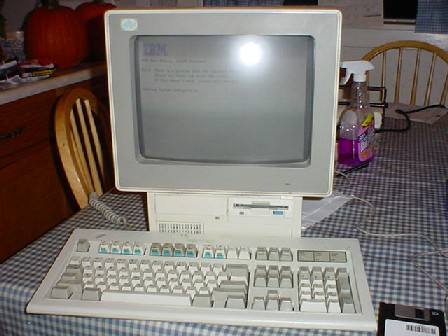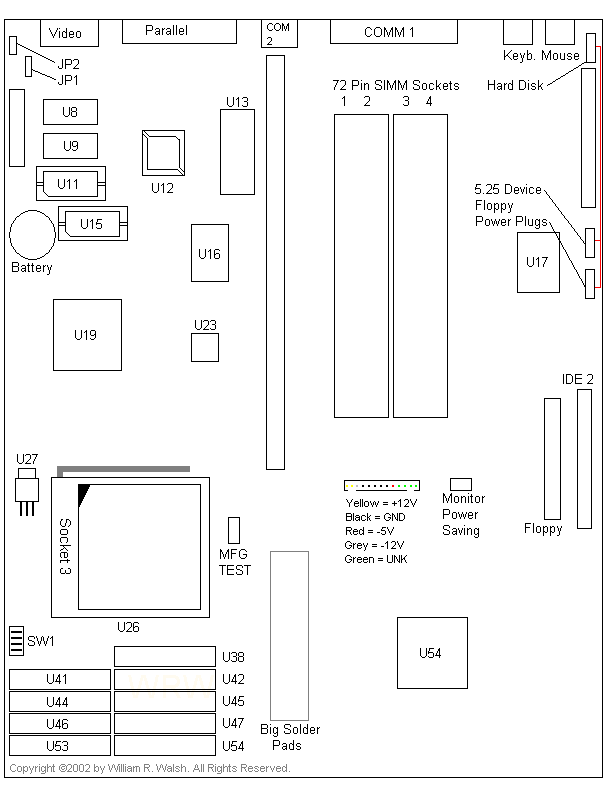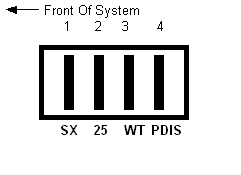EduQuest Model 55 9615-001

Planar Outline
Option Cards
Flash BIOS Update
Other Supporting Files
EduQuest "School Box" (whatever that may be)
This was another "recycling rescue". After purchasing and collecting it, I discovered some evidence that it had been left sitting in the weather for some period of time. Thankfully it still worked perfectly well. When I wrote this page for the first time, it was my understanding that the Models 50 and 55 were much the same thing. There is some suggestion that such is perhaps not the case.
Shown above in the picture is a keyboard with specially labeled function keys for some programs. While this EduQuest system is long gone, I still have its special keyboard!
It'd be pretentious of me to say that these pages have been anything like maintained since they were written in the early 2000s. They've basically slumbered since I created them. Very few people have come forward with any more information about these machines. The EduQuest division of IBM is long since gone, and even IBM itself is now out of the personal computer business. Whether timely or not, I cannot guarantee that there will be any further updates to these pages. Still, if you have information about these systems, their supporting software or even if you'd just like to share your story of having used/seen/bought one or whatever, I'd certainly like to hear from you. I no longer own any working EduQuest systems at this point in time, and don't expect that I'll ever find any more in future. - WW, September 2016
XT-IDE and the EduQuest
(This is primarily relevant to the EduQuest Models 30, 40 and others that have DOS-in-ROM present on the motherboard. By the time of the EduQuest 55, this seems to have been dropped.)
It is reported that when used normally, an XT-IDE adapter is not compatible with the EduQuest as its option ROM is not allowed to load. Chris Esch discovered that there is a solution in the form of removing the expansion ROM that contains the EduQuest's DOS-in-ROM functionality. From that point, the XT-IDE adapter's ROM can be placed into the socket from which the original DOS-in-ROM chip was removed. Be careful that you insert the chip correctly. Otherwise you may burn it or your EduQuest system out.
Power Supply
I noticed at times of changing load, that the power supply in all of my EduQuest systems would sometimes behave in an unstable manner. The screen image would shrink or "vibrate" noticeably if something like an internal CD-ROM drive were to spin up. None of them ever failed as a result of this, and I never got so far as to diagnose it. My best guess would be faulty or dried-out electrolytic capacitors that had changed in value, particularly any that were being used as power filters.
Planar

Comments: Looks to me like this is a vastly revised planar as compared to the EduQuest 30 and 40 where lots of the design stayed the same with only minor changes. You really can't compare this planar to the 30 and 40 models.
Missing from this board are a lot of what I consider to have been "vestigial features" on the 30 and 40 such as the ever present but always empty "Mask ROM" socket.
Looking at U27 (an LT1085 regulator commonly used for such things) and seeing no manual voltage switch I am inclined to believe that this board can automatically detect the voltage requirements of the CPU in use. There is a jumper not shown above that would let one select between 3.3 and 3.45 volts, but it is not populated (solder pads only) so that may be automatic as well.
Big Solder Pads are in an arrangement that looks like there may have been plans for a VL-bus version of this EduQuest.
Components:
Battery - CR2032
U8 - 512K Video RAM
U9 - 512K Video RAM - U8 and U9 total 1MB VRAM
U11 - VRAM Upgrade Socket
U12 - Intel Flash Chip (Flash BIOS update)
U13 - Marked as U13 ROM BIOS (could be used for bad flash recovery, this machine supports it)
U15 - Upgrade VRAM Socket
U16 - VLSI VL82C114
U17 - SMSC FDC37C65 (probably just a NEC 765 clone, so no 2.88 drives are supported)
U19 - Cirrus Logic 5434 Video
U23 - VLSI VL82C003
U26 - 80486/Pentium OverDrive Socket 3 (ZIF)
U27 - Linear Tech LT1085 Voltage Regulator
U38-53 Cache Sockets - U38 is probably the TAG RAM.
U54 - VL82C483
Jumpers/Connectors/Plugs:
SW1

Switches are "ON" when upwards
SX - Selects an i486SX or 'other' CPU
25 - Selects between 25 and 33MHz base clock speeds
WT - L1 Cache Operation Mode WT = Write-Thru or L1-WB = Level 1 Write Back
(write back improves performance drastically but may not be 100% compatible with certain processors and might increase the risk of data corruption on system failure)
PDIS - Your guess is as good as mine here...perhaps it enables or disables parity. For what is unknown.
JP1 - Power On Password Clear
JP2 - 1-2 (pin one is pads only) Boot Block Program, 2-3 Normal Operation (this may have to do with flash BIOS recovery support)
I'm not sure what the maximum amount of RAM this system can handle is. I wouldn't be suprised if it took 64MB. It appears to be standard non-parity stuff.
VRAM Sockets & Video Capabilities
I popped in two upgrade VRAMs into each socket and powered up. I was more than a little puzzled when the machine didn't report the new VRAM, but since they were rather crudely desoldered from another dead board, I figured maybe some pin straightening might be in order. That did the trick and got the system seeing all 2MB of installed VRAM.
Video is provided by a Cirrus 5434 accellerator. With 1MB VRAM you can run up to 256 colors in 1024x768. (Oddly enough 1MB is not enough VRAM for 800x600 at high color, only 256) With all 2MB installed, you can run at least high color in all supported modes (640x480 to 1024x768).
It appears that the video BIOS has been customized for the internal monitor, and all SVGA modes run at 72Hz scan rate. You can connect an external monitor, though what would change about the video chip's behavior I don't yet know. System setup has an option to disable the internal display if you're using modes it wouldn't support.
Flash BIOS
Download the self-extracting file here. This is the genuine and original IBM file. It will take your EduQuest system from revision 00G to 05G.
Extraction may need to be done under pure DOS and not Windows NT, as when run on an NT system, no keyboard input to the program was possible.
NOTICE: Though most BIOS flash operations go as planned, errors are possible due to power failures, problems with the flash source and other little things that can go wrong. While I don't want to discourage you from applying this update if you need it, I don't advise applying it just because it is here and you can. Please make sure that your machine is in fact an EduQuest Model 55 and make the flash "undo diskette" prior to updating.
This update is provided on a "use at your own risk" basis. YOU are responsible for the results of using it, whether good or bad.
This flash update supposedly fixes floppy drive read and write errors.
Other Supporting Files
Andrew Lawton supplied an archive containing several EduQuest Model 55 specific files, including the previously mentioned flash BIOS update. You can download them here. I have not personally used or tested them and I have no idea what they are intended for. As such, and as always, you use them at your own risk.
EduQuest "School Box"
I have no idea what it is or does, as I haven't tried it. It's described as some sort of driver and diagnostic package. So, naturally, the same disclaimer you've heard several times by now applies. Strongly. But if you still have an EduQuest 55, you might find it useful. Click here to download it. (Originally uploaded in this thread of discussion. Posted here in the name of preservation and because -- rather amazingly -- a link that was posted five years ago and labeled as "temporary" still worked. Sometimes you just get lucky.)
Go Back>
Copyright © 2002-2016 William R. Walsh. Some rights reserved.